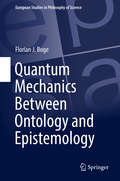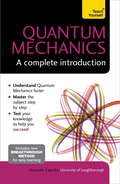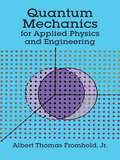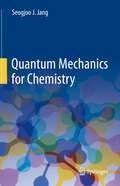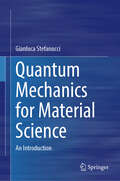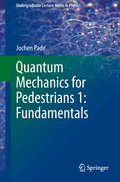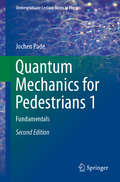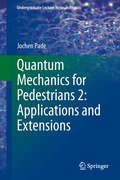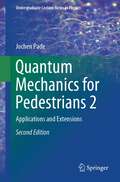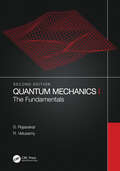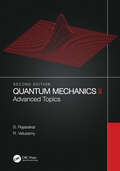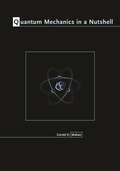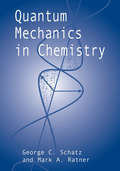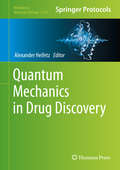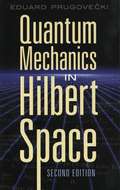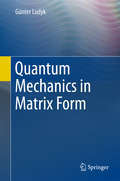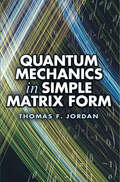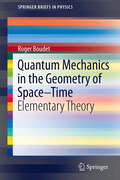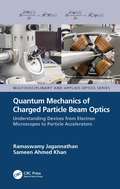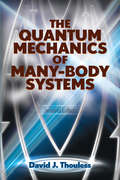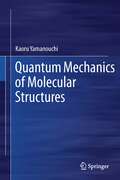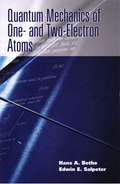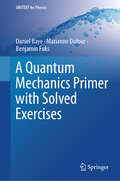- Table View
- List View
Quantum Mechanics Between Ontology and Epistemology (European Studies in Philosophy of Science #10)
by Florian J. BogeThis book explores the prospects of rivaling ontological and epistemic interpretations of quantum mechanics (QM). It concludes with a suggestion for how to interpret QM from an epistemological point of view and with a Kantian touch. It thus refines, extends, and combines existing approaches in a similar direction. The author first looks at current, hotly debated ontological interpretations. These include hidden variables-approaches, Bohmian mechanics, collapse interpretations, and the many worlds interpretation. He demonstrates why none of these ontological interpretations can claim to be the clear winner amongst its rivals. Next, coverage explores the possibility of interpreting QM in terms of knowledge but without the assumption of hidden variables. It examines QBism as well as Healey’s pragmatist view. The author finds both interpretations or programs appealing, but still wanting in certain respects. As a result, he then goes on to advance a genuine proposal as to how to interpret QM from the perspective of an internal realism in the sense of Putnam and Kant. The book also includes two philosophical interludes. One details the notions of probability and realism. The other highlights the connections between the notions of locality, causality, and reality in the context of violations of Bell-type inequalities.
Quantum Mechanics: A Complete Introduction: Teach Yourself
by Alexandre ZagoskinWritten by Dr Alexandre Zagoskin, who is a Reader at Loughborough University, Quantum Mechanics: A Complete Introduction is designed to give you everything you need to succeed, all in one place. It covers the key areas that students are expected to be confident in, outlining the basics in clear jargon-free English, and then providing added-value features like summaries of key ideas, and even lists of questions you might be asked in your exam. The book uses a structure that is designed to make quantum physics as accessible as possible - by starting with its similarities to Newtonian physics, rather than the rather startling differences.
The Quantum Mechanics Conundrum: Interpretation and Foundations
by Gennaro AulettaThis comprehensive volume gives a balanced and systematic treatment of both the interpretation and the mathematical-conceptual foundations of quantum mechanics. It is written in a pedagogical style and addresses many thorny problems of fundamental physics.The first aspect concerns Interpretation. The author raises the central problems: formalism, measurement, non-locality, and causality. The main positions on these subjects are presented and critically analysed. The aim is to show that the main schools can converge on a core interpretation. The second aspect concerns Foundations. Here it is shown that the whole theory can be grounded on information theory. The distinction between information and signal leads us to integrating quantum mechanics and relativity. Category theory is presented and its significance for quantum information shown; the logic and epistemological bases of the theory are assessed.Of relevance to all physicists and philosophers with an interest in quantum theory and its foundations, this book is destined to become a classic work.
Quantum Mechanics for Applied Physics and Engineering
by Albert T. Fromhold Jr.For upper-level undergraduates and graduate students: an introduction to the fundamentals of quantum mechanics, emphasizing aspects essential to an understanding of solid-state theory. A heavy background in mathematics and physics is not required beyond basic courses in calculus, differential equations, and calculus-based elementary physics. Numerous problems (and selected answers), projects, exercises.
Quantum Mechanics for Chemistry
by Seogjoo J. JangThis textbook forms the basis for an advanced undergraduate or graduate level quantum chemistry course, and can also serve as a reference for researchers in physical chemistry and chemical physics. In addition to the standard core topics such as principles of quantum mechanics, vibrational and rotational states, hydrogen-like molecules, perturbation theory, variational principles, and molecular orbital theories, this book also covers essential theories of electronic structure calculation, the primary methods for calculating quantum dynamics, and major spectroscopic techniques for quantum measurement. Plus, topics that are overlooked in conventional textbooks such as path integral formulation, open system quantum dynamics methods, and Green’s function approaches are addressed. This book helps readers grasp the essential quantum mechanical principles and results that serve as the foundation of modern chemistry and become knowledgeable in major methods of computational chemistry and spectroscopic experiments being conducted by present-day researchers. Dirac notation is used throughout, and right balance between comprehensiveness, rigor, and readability is achieved, ensuring that the book remains accessible while providing all the relevant details. Complete with exercises, this book is ideal for a course on quantum chemistry or as a self-study resource.
Quantum Mechanics for Material Science: An Introduction
by Gianluca StefanucciThis book is based on the course "Elements of Theoretical Physics," which the author has been teaching at the University of Rome Tor Vergata since 2017. It serves as an introduction to quantum mechanics, providing students with essential concepts and tools for future lessons, while still maintaining a comprehensive approach without relying heavily on the level of abstraction and mathematical rigor typically found in Physics programs. Understanding this book only requires knowledge of the mathematical concepts taught in the first two years of basic courses. The bachelor's degree program in Materials Science aims to train students with an interdisciplinary background in physics, chemistry, and engineering. While the study of quantum mechanics is essential, the same level of depth, abstraction, and mathematical rigor as in a Physics degree program is not a requirement. Unfortunately, most textbooks on Quantum Mechanics are geared toward Physics students, making it difficult to find suitable resources for Materials Science students. To make learning easier, the author has chosen not to refer students to various textbooks for different topics. Instead, he has created handouts that have evolved into a condensed textbook on quantum mechanics specifically tailored to the needs of the Materials Science program.
Quantum Mechanics for Pedestrians 1: Fundamentals
by Jochen PadeThis book provides an introduction into the fundamentals of non-relativistic quantum mechanics. In Part 1, the essential principles are developed. Applications and extensions of the formalism can be found in Part 2. The book includes not only material that is presented in traditional textbooks on quantum mechanics, but also discusses in detail current issues such as interaction-free quantum measurements, neutrino oscillations, various topics in the field of quantum information as well as fundamental problems and epistemological questions, such as the measurement problem, entanglement, Bell's inequality, decoherence, and the realism debate. A chapter on current interpretations of quantum mechanics concludes the book. To develop quickly and clearly the main principles of quantum mechanics and its mathematical formulation, there is a systematic change between wave mechanics and algebraic representation in the first chapters. The required mathematical tools are introduced step by step. Moreover, the appendix collects compactly the most important mathematical tools that supplementary literature can be largely dispensed. In addition, the appendix contains advanced topics, such as Quantum- Zeno effect, time-delay experiments, Lenz vector and the Shor algorithm. About 250 exercises, most of them with solutions, help to deepen the understanding of the topics. Target groups of the book are student teachers and all students of physics, as minor or major, looking for a reasonably easy and modern introduction into quantum mechanics.
Quantum Mechanics for Pedestrians 1: Fundamentals (Undergraduate Lecture Notes in Physics)
by Jochen PadeThis book, the first in a two-volume set, provides an introduction to the fundamentals of (mainly) non-relativistic quantum mechanics. This first volume chiefly focuses on the essential principles, while applications and extensions of the formalism can be found in volume 2. Including but also moving beyond material that is covered in traditional textbooks on quantum mechanics, the book discusses in detail current issues such as interaction-free quantum measurements or neutrino oscillations, as well as fundamental problems and epistemological questions, such as the measurement problem. A chapter on the postulates of quantum mechanics rounds off this first volume. In order to quickly and clearly present the main principles of quantum mechanics and its mathematical formulation, there is a systematic transition between wave mechanics and algebraic representation in the first few chapters, in which the required mathematical tools are introduced step by step. Moreover, the appendix concisely reviews the most important mathematical tools, allowing readers to largely dispense with supplementary literature. The appendix also explores advanced topics, such as the Quantum-Zeno effect and time-delay experiments. Over 250 exercises, most of them with solutions, help to deepen the reader’s understanding of the topics discussed. This revised second edition is expanded by an introduction to some ideas and problems of relativistic quantum mechanics. In this first volume, the Klein-Gordon and the Dirac equations are treated. Fundamentals of other areas are compiled in compact form, i.e., outlines of special relativity, classical field theory and electrodynamics. The book is chiefly intended for student science teachers and all students of physics, majors and minors alike, who are looking for a reasonably easy and modern introduction to quantum mechanics.
Quantum Mechanics for Pedestrians 2: Applications and Extensions
by Jochen PadeThe two-volume textbook Quantum Mechanics for Pedestrians provides an introduction to the basics of nonrelativistic quantum mechanics. Originally written as a course for students of science education, the book addresses all those science students and others who are looking for a reasonably simple, fresh and modern introduction to the field. The basic principles of quantum mechanics are presented in the first volume. This second volume discusses applications and extensions to more complex problems. In addition to topics traditionally dealt with in quantum mechanics texts, such as symmetries or many-body problems, here also issues of current interest such as entanglement, Bell's inequalities, decoherence and various aspects of quantum information are treated in detail. Furthermore, questions of the basis of quantum mechanics and epistemological issues are discussed explicitly; these are relevant e. g. to the realism debate. A chapter on the interpretations of quantum mechanics completes this volume. The necessary mathematical tools are introduced step by step; in the appendix, the most relevant mathematics is compiled in compact form. More advanced topics such as the Lenz vector, Hardy's experiment and Shor's algorithm are treated in more detail in the appendix. As an essential aid to learning and teaching, 130 exercises are included, most of them with their solutions.
Quantum Mechanics for Pedestrians 2: Applications and Extensions (Undergraduate Lecture Notes in Physics)
by Jochen PadeThis book, the second in a two-volume set, provides an introduction to the basics of (mainly) non-relativistic quantum mechanics. While the first volume addresses the basic principles, this second volume discusses applications and extensions to more complex problems. In addition to topics dealt with in traditional quantum mechanics texts, such as symmetries or many-body problems, it also treats issues of current interest such as entanglement, Bell’s inequality, decoherence and various aspects of quantum information in detail. Furthermore, questions concerning the basis of quantum mechanics and epistemological issues which are relevant e.g. to the realism debate are discussed explicitly. A chapter on the interpretations of quantum mechanics rounds out the book. Readers are introduced to the requisite mathematical tools step by step. In the appendix, the most relevant mathematics is compiled in compact form, and more advanced topics such as the Lenz vector, Hardy’s experiment and Shor’s algorithm are treated in more detail. As an essential aid to learning and teaching, 130 exercises are included, most of them with solutions. This revised second edition is expanded by an introduction into some ideas and problems of relativistic quantum mechanics. In this second volume, an overview of quantum field theory is given and basic conceptions of quantum electrodynamics are treated in some detail. Originally written as a course for students of science education, the book addresses all those science students and others who are looking for a reasonably simple, fresh and modern introduction to the field.
Quantum Mechanics for Scientists and Engineers
by David A. B. MillerIf you need a book that relates the core principles of quantum mechanics to modern applications in engineering, physics, and nanotechnology, this is it. Students will appreciate the book's applied emphasis, which illustrates theoretical concepts with examples of nanostructured materials, optics, and semiconductor devices. The many worked examples and more than 160 homework problems help students to problem solve and to practise applications of theory. Without assuming a prior knowledge of high-level physics or classical mechanics, the text introduces Schrdinger's equation, operators, and approximation methods. Systems, including the hydrogen atom and crystalline materials, are analyzed in detail. More advanced subjects, such as density matrices, quantum optics, and quantum information, are also covered. Practical applications and algorithms for the computational analysis of simple structures make this an ideal introduction to quantum mechanics for students of engineering, physics, nanotechnology, and other disciplines. Additional resources available from www. cambridge. org/9780521897839.
Quantum Mechanics I: The Fundamentals
by S. Rajasekar R. VelusamyQuantum Mechanics I: The Fundamentals provides a graduate-level account of the behavior of matter and energy at the molecular, atomic, nuclear, and sub-nuclear levels. It covers basic concepts, mathematical formalism, and applications to physically important systems. This fully updated new edition addresses many topics not typically found in books at this level, including: Bound state solutions of quantum pendulum Morse oscillator Solutions of classical counterpart of quantum mechanical systems A criterion for bound state Scattering from a locally periodic potential and reflection-less potential Modified Heisenberg relation Wave packet revival and its dynamics An asymptotic method for slowly varying potentials Klein paradox, Einstein-Podolsky-Rosen (EPR) paradox, and Bell’s theorem Delayed-choice experiments Fractional quantum mechanics Numerical methods for quantum systems A collection of problems at the end of each chapter develops students’ understanding of both basic concepts and the application of theory to various physically important systems. This book, along with the authors’ follow-up Quantum Mechanics II: Advanced Topics, provides students with a broad, up-to-date introduction to quantum mechanics. Print Versions of this book also include access to the ebook version.
Quantum Mechanics II: Advanced Topics
by S. Rajasekar R. VelusamyQuantum Mechanics II: Advanced Topics offers a comprehensive exploration of the state-of-the-art in various advanced topics of current research interest. A follow-up to the authors’ introductory book Quantum Mechanics I: The Fundamentals, this book expounds basic principles, theoretical treatment, case studies, worked-out examples and applications of advanced topics including quantum technologies. A thoroughly revised and updated this unique volume presents an in-depth and up-to-date progress on the growing topics including latest achievements on quantum technology. In the second edition six new chapters are included and the other ten chapters are extensively revised. Features Covers classical and quantum field theories, path integral formalism and supersymmetric quantum mechanics. Highlights coherent and squeezed states, Berry’s phase, Aharonov—Bohm effect and Wigner function. Explores salient features of quantum entanglement and quantum cryptography. Presents basic concepts of quantum computers and the features of no-cloning theorem and quantum cloning machines. Describes the theory and techniques of quantum tomography, quantum simulation and quantum error correction. Introduces other novel topics including quantum versions of theory of gravity, cosmology, Zeno effect, teleportation, games, chaos and steering. Outlines the quantum technologies of ghost imaging, detection of weak amplitudes and displacements, lithography, metrology, teleportation of optical images, sensors, batteries and internet. Contains several worked-out problems and exercises in each chapter. Quantum Mechanics II: Advanced Topics addresses various currently emerging exciting topics of quantum mechanics. It emphasizes the fundamentals behind the latest cutting-edge developments to help explain the motivation for deeper exploration. The book is a valuable resource for graduate students in physics and engineering wishing to pursue research in quantum mechanics.
Quantum Mechanics in a Nutshell (In a Nutshell #5)
by Gerald D. MahanCovering the fundamentals as well as many special topics of current interest, this is the most concise, up-to-date, and accessible graduate-level textbook on quantum mechanics available. Written by Gerald Mahan, a distinguished research physicist and author of an acclaimed textbook on many-particle physics, Quantum Mechanics in a Nutshell is the distillation of many years' teaching experience. Emphasizing the use of quantum mechanics to describe actual quantum systems such as atoms and solids, and rich with interesting applications, the book proceeds from solving for the properties of a single particle in potential; to solving for two particles (the helium atom); to addressing many-particle systems. Applications include electron gas, magnetism, and Bose-Einstein Condensation; examples are carefully chosen and worked; and each chapter has numerous homework problems, many of them original. Quantum Mechanics in a Nutshell expertly addresses traditional and modern topics, including perturbation theory, WKBJ, variational methods, angular momentum, the Dirac equation, many-particle wave functions, Casimir Force, and Bell's Theorem. And it treats many topics--such as the interactions between photons and electrons, scattering theory, and density functional theory--in exceptional depth. A valuable addition to the teaching literature, Quantum Mechanics in a Nutshell is ideally suited for a two-semester course. The most concise, up-to-date, and accessible graduate textbook on the subject Contains the ideal amount of material for a two-semester course Focuses on the description of actual quantum systems, including a range of applications Covers traditional topics, as well as those at the frontiers of research Treats in unprecedented detail topics such as photon-electron interaction, scattering theory, and density functional theory Includes numerous homework problems at the end of each chapter
Quantum Mechanics in Chemistry (Dover Books On Chemistry Ser.)
by George C. Schatz Mark A. RatnerIntended for graduate and advanced undergraduate students, this text explores quantum mechanical techniques from the viewpoint of chemistry and materials science. Dynamics, symmetry, and formalism are emphasized. An initial review of basic concepts from introductory quantum mechanics is followed by chapters examining symmetry, rotations, and angular momentum addition. Chapter 4 introduces the basic formalism of time-dependent quantum mechanics, emphasizing time-dependent perturbation theory and Fermi’s golden rule. Chapter 5 sees this formalism applied to the interaction of radiation and matter. In Chapter 6, the authors introduce occupation number representations, including applications to both quantized radiation fields and electronic structure; while chapters 7 and 8 focus on scattering theory and basic theories of chemical reaction rates. The remaining three chapters deal with the use of correlation functions and density matrices in quantum mechanics. Problems and a bibliography appear at the end of each chapter; and at the end of the book there is an Appendix C, "Solutions to Problems," new to this edition.
Quantum Mechanics in Drug Discovery (Methods in Molecular Biology #2114)
by Alexander HeifetzThis volume looks at applications of quantum mechanical (QM) methods in drug discovery. The chapters in this book describe how QM approaches can be applied to address key drug discovery issues, such as characterizing protein-water-ligand and protein-protein interactions, providing estimates of binding affinities, determining ligand energies and bioactive conformations, refinement of molecular geometries, scoring docked protein–ligand poses, describing molecular similarity, structure–activity-relationship (SAR) analysis, and ADMET prediction. Written in the highly successful Methods in Molecular Biology series format, chapters include introductions to their respective topics, lists of the necessary software and tools, step-by-step, readily reproducible modeling protocols, and tips on troubleshooting and avoiding known pitfalls. Cutting-edge and unique, Quantum Mechanics in Drug Discovery is a valuable resource for structural and molecular biologists, computational and medicinal chemists, pharmacologists, and drug designers.
Quantum Mechanics in Hilbert Space: Second Edition (Dover Books on Physics)
by Eduard PrugoveckiA critical presentation of the basic mathematics of nonrelativistic quantum mechanics, this text is suitable for courses in functional analysis at the advanced undergraduate and graduate levels. Its readable and self-contained form is accessible even to students without an extensive mathematical background. Applications of basic theorems to quantum mechanics make it of particular interest to mathematicians working in functional analysis and related areas.This text features the rigorous proofs of all the main functional-analytic statements encountered in books on quantum mechanics. It fills the gap between strictly physics- and mathematics-oriented texts on Hilbert space theory as applied to nonrelativistic quantum mechanics. Organized in the form of definitions, theorems, and proofs of theorems, it allows readers to immediately grasp the basic concepts and results. Exercises appear throughout the text, with hints and solutions at the end.
Quantum Mechanics in Matrix Form
by Günter LudykThis book gives an introduction to quantum mechanics with the matrix method. Heisenberg's matrix mechanics is described in detail. The fundamental equations are derived by algebraic methods using matrix calculus. Only a brief description of Schrödinger's wave mechanics is given (in most books exclusively treated), to show their equivalence to Heisenberg's matrix method. In the first part the historical development of Quantum theory by Planck, Bohr and Sommerfeld is sketched, followed by the ideas and methods of Heisenberg, Born and Jordan. Then Pauli's spin and exclusion principles are treated. Pauli's exclusion principle leads to the structure of atoms. Finally, Dirac´s relativistic quantum mechanics is shortly presented. Matrices and matrix equations are today easy to handle when implementing numerical algorithms using standard software as MAPLE and Mathematica.
Quantum Mechanics in Simple Matrix Form (Dover Books on Physics)
by Thomas F. JordanThis elementary text introduces basic quantum mechanics to undergraduates with no background in mathematics beyond algebra. Containing more than 100 problems, it provides an easy way to learn part of the quantum language and apply it to problems.Emphasizing the matrices representing physical quantities, it describes states simply by mean values of physical quantities or by probabilities for possible values. This approach requires using the algebra of matrices and complex numbers together with probabilities and mean values, a technique introduced at the outset and used repeatedly. Students discover the essential simplicity of quantum mechanics by focusing on basics and working only with key elements of the mathematical structure--an original point of view that offers a refreshing alternative for students new to quantum mechanics.
Quantum Mechanics in the Geometry of Space-Time
by Roger BoudetThis book continues the fundamental work of Arnold Sommerfeld and David Hestenes formulating theoretical physics in terms of Minkowski space-time geometry. We see how the standard matrix version of the Dirac equation can be reformulated in terms of a real space-time algebra, thus revealing a geometric meaning for the "number i" in quantum mechanics. Next, it is examined in some detail how electroweak theory can be integrated into the Dirac theory and this way interpreted in terms of space-time geometry. Finally, some implications for quantum electrodynamics are considered. The presentation of real quantum electromagnetism is expressed in an addendum. The book covers both the use of the complex and the real languages and allows the reader acquainted with the first language to make a step by step translation to the second one.
Quantum Mechanics of Charged Particle Beam Optics: Understanding Devices from Electron Microscopes to Particle Accelerators (Multidisciplinary and Applied Optics)
by Ramaswamy Jagannathan Sameen Ahmed KhanClassical Charged Particle Beam Optics used in the design and operation of all present-day charged particle beam devices, from low energy electron microscopes to high energy particle accelerators, is entirely based on classical mechanics. A question of curiosity is: How is classical charged particle beam optics so successful in practice though the particles of the beam, like electrons, are quantum mechanical? Quantum Mechanics of Charged Particle Beam Optics answers this question with a comprehensive formulation of ‘Quantum Charged Particle Beam Optics’ applicable to any charged particle beam device.
The Quantum Mechanics of Many-Body Systems: Second Edition (Dover Books on Physics)
by D. J. ThoulessThis monograph introduces advanced undergraduates and graduate students of physics to the "many-body" theory in theoretical physics. The treatment addresses problems and solutions related to nuclear and atomic physics, the electron theory of metals, and the theories of liquid helium three and four. A unified account of the field rather than a description of parallel methods, the text's main thematic approaches include the self-consistent field and its generalizations, perturbation theory and the use of Feynman diagrams, and the use of Green functions to describe excitations of a many-body system. The primary emphasis is on the theories of atomic nuclei, the electron gas, superconductivity, and liquid helium three. A familiarity with the principles of nonrelativistic quantum mechanics and statistical mechanics is assumed, but a detailed knowledge of nuclear and solid state physics is unnecessary.
Quantum Mechanics of Molecular Structures
by Kaoru YamanouchiAt a level accessible to advanced undergraduates, this textbook explains the fundamental role of quantum mechanics in determining the structure, dynamics, and other properties of molecules. Readers will come to understand the quantum-mechanical basis for harmonic oscillators, angular momenta and scattering processes. Exercises are provided to help readers deepen their grasp of the essential phenomena.
Quantum Mechanics of One- and Two-Electron Atoms (Dover Books on Physics)
by Edwin E. Salpeter Hans A. BetheThis classic of modern physics includes a vast array of approximation methods, mathematical tricks, and physical pictures that are also useful in the application of quantum mechanics to other fields. Students and professionals will find it an essential reference for calculations pertaining to hydrogen-like and helium-like atoms and their comparison with experimental results. In-depth explorations of the Dirac theory of the electron and of radiative effects include brief accounts of relevant experiments. The specific application of general field-theoretic results to atomic systems also receives a thorough examination. Author Hans A. Bethe (1906-2005), Professor of Physics at Cornell University, won the Nobel Prize in Physics in 1967. Co-author Edwin E. Salpeter is James Gilbert White Distinguished Professor of the Physical Sciences at Cornell University.
A Quantum Mechanics Primer with Solved Exercises (UNITEXT for Physics)
by Daniel Baye Marianne Dufour Benjamin FuksThis book provides a comprehensive introduction to quantum mechanics, supported by numerous solved exercises. Aiming to be both exhaustive and educational, it minimises overly formal aspects by presenting the wave mechanical approach to quantum mechanics. The book simplifies and rigorously covers a large set of fundamental topics such as potential wells and barriers, wave packets, harmonic oscillators, and the hydrogen atom. It also addresses spin and, in simple terms, the conceptual difficulties of quantum physics and Bell’s inequalities. The discussion extends to relativistic quantum mechanics. Each chapter includes exercises designed to test comprehension and facilitate optimal assimilation of the material, and are followed by detailed solutions. Intended for both personal study and course support, this book is valuable for anyone curious about the subject. However, it is specifically targeted at undergraduate and master’s students in physics, chemistry, and mathematics, as well as engineering students.
